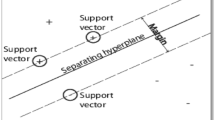Abstract
A comprehensive insight into the epileptiform discharges at the time of seizure onset can aid neurophysiologists in the diagnosis and treatment of epileptic seizures. Visual analysis of seizure onset patterns is often a complex and tedious task. These problems suggest the development of automated seizure onset detection systems. The present research work is oriented for automatic detection of epileptic seizures at the onset using statistical measures. A quadratic classifier with fourfold cross-validation is used to demarcate the seizure and non-seizure activity. The algorithm is evaluated for 24 patients from the CHB MIT scalp EEG database. Classifier performance is assessed in terms of sensitivity, specificity, accuracy, and latency.









Similar content being viewed by others
Abbreviations
- ANN:
-
Artificial Neural Network
- CHB:
-
Children’s Hospital Boston
- DWN:
-
Dynamic Wavelet Network
- DWT:
-
Discrete Wavelet Transform
- EEG:
-
Electroencephalogram
- FEBANN:
-
Feedforward Error Backpropagation Artificial Neural Network
- FN:
-
False Negative
- FP:
-
False Positive
- MIT:
-
Massachusetts Institute of Technology
- TN:
-
True Negative
- TP:
-
True Positive
References
Corsini J, Shoker L, Sanei S, Alarcón G (2006) Epileptic seizure predictability from scalp EEG incorporating constrained blind source separation. IEEE Trans Biomed Eng 53:790–799
Shoeb A, Guttag J (2010) Application of machine learning to epileptic seizure detection. In: 27th international conference on machine learning, Haifa, Israel, June 2010, pp 975–982
Prior PF, Virden RSM, Maynard DE (1973) An EEG device for monitoring seizure discharges. Epilepsia 14:367–372
Ives JR (1974) The on-line computer detection and recording of spontaneous temporal lobe epileptic seizures from patients with implanted depth electrodes via a radio telemetry link. Electoencephalogr Clin Neurophysiol 37:205
Gotman J (1982) Automatic recognition of epileptic seizures in the EEG. Electoen Clin Neurophysiol 54(5):530–540
Khan YU, Gotman J (2003) Wavelet based automatic seizure detection in intracerebral electroencephalogram. Clin Neurophysiol 114(5):898–908
Shoeb AH (2003) Patient-specific seizure onset detection. M.S. thesis, Dept. Elect. & Comp Sc., MIT Univ., Cambridge, MA
Subasi A (2005) Epileptic seizure detection using dynamic wavelet network. Expert Syst Appl 29:343–355
Kharbouch AA (2012) Automatic detection of epileptic seizure onset and termination using intracranial EEG. M.S. thesis, Dept. Elect. & Comp Sc., MIT Univ., Cambridge, MA
Khan AT, Khan YU (2018) Dual tree complex wavelet transform based analysis of epileptiform discharges. Int J Inf Technol 10:543. https://doi.org/10.1007/s41870-018-0149-5
Achilles F, Tombari F, Belagiannis V, Loesch AM, Noachtar S, Navab N (2018) Convolutional neural networks for real-time epileptic seizure detection. Comput Methods Biomech Biomed Eng Imaging Vis 6(3):264–269. https://doi.org/10.1080/21681163.2016.1141062
Subasi A, Kevric J, Abdullah Canbaz M (2019) Epileptic seizure detection using hybrid machine learning methods. Neural Comput Appl 31:317. https://doi.org/10.1007/s00521-017-3003-y
Bhattacharyya A, Singh L, Pachori RB (2019) Identification of epileptic seizures from scalp EEG signals based on TQWT. In: Tanveer M, Pachori R (eds) Machine intelligence and signal analysis, vol 748. Advances in intelligent systems and computing. Springer, Singapore
Rafiuddin N, Khan YU, Farooq O (2011) Feature extraction and classification of EEG for automatic seizure detection. In: International conference on multimedia, signal processing and communication technologies, Aligarh, pp 184–187
Mihajlovic V, Patki S, Grundlehner B (2014) The impact of head movements on EEG and contact impedance: an adaptive filtering solution for motion artifact reduction. In: 36th annual international conference of the IEEE engineering in medicine and biology society (EMBC), Chicago, pp 5064–5067
Rafi N, Khan YU, Farooq O (2014) Epileptic seizure detection: reformation of the traditional method on scalp recorded electroencephalogram. In: International conference on emerging trends in electrical engineering, Kollam, pp 1–6
Author information
Authors and Affiliations
Corresponding author
Rights and permissions
About this article
Cite this article
Khan, A.T., Khan, Y.U. Time domain based seizure onset analysis of brain signatures in pediatric EEG. Int. j. inf. tecnol. 13, 453–458 (2021). https://doi.org/10.1007/s41870-020-00596-5
Received:
Accepted:
Published:
Issue Date:
DOI: https://doi.org/10.1007/s41870-020-00596-5




